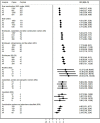Pleural mesothelioma risk in the construction industry: a case-control study in Italy, 2000-2018
- PMID: 37567753
- PMCID: PMC10423786
- DOI: 10.1136/bmjopen-2023-073480
Pleural mesothelioma risk in the construction industry: a case-control study in Italy, 2000-2018
Abstract
Objectives: Workers in the construction industry have been exposed to asbestos in various occupations. In Italy, a National Mesothelioma Registry has been implemented more than 20 years ago. Using cases selected from this registry and exploiting existing control data sets, we estimated relative risks for pleural mesothelioma (PM) among construction workers.
Design: Case-control study.
Setting: Cases from the National Mesothelioma Registry (2000-2018), controls from three previous case-control studies.
Methods: We selected male PM incident cases diagnosed in 2000-2018. Population controls were taken from three studies performed in six Italian regions within two periods (2002-2004 and 2012-2016). Age-adjusted and period-adjusted unconditional logistic regression models were fitted to estimate odds ratios (OR) for occupations in the construction industry. We followed two approaches, one (primary) excluding and the other (secondary) including subjects employed in other non-construction blue collar occupations for >5 years. For both approaches, we performed an overall analysis including all cases and, given the incomplete temporal and geographic overlap of cases and controls, three time or/and space restricted sensitivity analyses.
Results: The whole data set included 15 592 cases and 2210 controls. With the primary approach (4797 cases and 1085 controls), OR was 3.64 (2181 cases) for subjects ever employed in construction. We found elevated risks for blue-collar occupations (1993 cases, OR 4.52), including bricklayers (988 cases, OR 7.05), general construction workers (320 cases, OR 4.66), plumbers and pipe fitters (305 cases, OR 9.13), painters (104 cases, OR 2.17) and several others. Sensitivity analyses yielded very similar findings. Using the secondary approach, we observed similar patterns, but ORs were remarkably lower.
Conclusions: We found markedly increased PM risks for most occupations in the construction industry. These findings are relevant for compensation of subjects affected with mesothelioma in the construction industry.
Keywords: case-control studies; epidemiology; occupational & industrial medicine; public health; respiratory tract tumours.
© Author(s) (or their employer(s)) 2023. Re-use permitted under CC BY-NC. No commercial re-use. See rights and permissions. Published by BMJ.
Conflict of interest statement
Competing interests: DCo, SMa and CM served as consultants in trials concerning asbestos-related diseases.
Figures



References
-
- GBD 2017 Risk Factor Collaborators . Global, regional, and national comparative risk assessment of 84 behavioural, environmental and occupational, and metabolic risks or clusters of risks for 195 countries and territories, 1990-2017: a systematic analysis for the global burden of disease study 2017. Lancet 2018;392:1923–94. - PMC - PubMed
-
- GBD 2016 Occupational Carcinogens Collaborators . Occupational Carcinogens collaborators. global and regional burden of cancer in 2016 arising from occupational exposure to selected carcinogens: a systematic analysis for the global burden of disease study 2016. Occup Environ Med 2020;77:151–9. 10.1136/oemed-2019-106012 - DOI - PMC - PubMed
Publication types
MeSH terms
Substances
LinkOut - more resources
Full Text Sources
Medical
